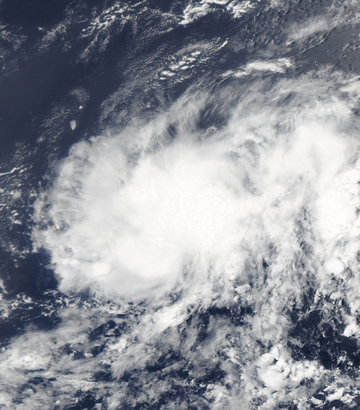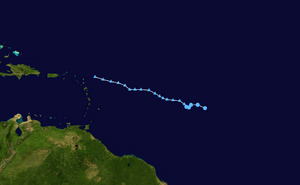Tropical Depression Ten (2005) facts for kids
| Tropical Depression (SSHWS/NWS) | |

Tropical Depression 10
|
|
| Formed | August 13, 2005 |
|---|---|
| Dissipated | August 22, 2005 (remnant low after August 14) |
| Highest winds | 1-minute sustained: 35 mph (55 km/h) |
| Lowest pressure | 1008 mbar (hPa); 29.77 inHg |
| Fatalities | None reported |
| Damage | None |
| Areas affected | None |
| Part of the 2005 Atlantic hurricane season | |
Tropical Depression Ten was a weak tropical cyclone that formed during the 2005 Atlantic hurricane season. It was the tenth tropical storm or depression of that year. It started as a tropical wave on August 8, 2005, and officially became a tropical depression on August 13.
This storm stayed weak because of strong winds high up in the atmosphere, called wind shear. It never became a stronger tropical storm or hurricane. Tropical Depression Ten did not hit any land or cause any damage. It mostly faded away on August 14. However, parts of it later helped create Hurricane Katrina, which became one of the most powerful and damaging hurricanes in the history of the United States.
Contents
How Tropical Depression Ten Formed
Tropical Depression Ten began as a tropical wave. This is a low-pressure area that moves across the ocean. This wave entered the Atlantic Ocean on August 8, 2005. It then traveled west. By August 11, it started to look like it might get stronger.
The system officially became Tropical Depression Ten on August 13. At that time, it was about 1,600 miles (2,600 km) (about 2,575 km) east of Barbados. When it first formed, it had many thunderstorms and curved rainbands, which are bands of rain and wind.

Why the Storm Stayed Weak
The depression slowly moved west. Strong wind shear kept it from getting much stronger. Wind shear happens when winds at different heights blow in different directions or at different speeds. This can tear a storm apart.
On August 13, a weather forecaster noted that the storm looked similar to Hurricane Irene. This was because of the wind shear affecting the storm's lower parts.
The End of Tropical Depression Ten
Early on August 14, the strong wind shear broke the storm apart. The center of the storm moved away from its thunderstorms. Later that day, the cyclone became even weaker.
The National Hurricane Center then issued its final warning for Tropical Depression Ten. The storm mostly disappeared. However, its leftover energy caused a few more bursts of thunderstorms for several days. It completely stopped by August 18.
Connection to Hurricane Katrina
Even though Tropical Depression Ten faded away, some of its energy helped form a new storm. This new storm was Tropical Depression Twelve. It formed over the southeastern Bahamas on August 23.
Usually, if a storm disappears and then forms again, it keeps its original number. But Tropical Depression Twelve also involved other weather systems, including another tropical wave. Because of this, it was given a new number. Tropical Depression Twelve later grew into Hurricane Katrina.
What Was the Impact?
Tropical Depression Ten did not hit any land. Because of this, no warnings were needed for people on land.
The storm did not cause any damage or deaths. No ships reported strong winds from it either. Since it never became a tropical storm, it was never given a name by the National Hurricane Center.
After Tropical Depression Ten mostly disappeared, parts of its remains helped create Tropical Depression Twelve. This storm later became Hurricane Katrina. Katrina grew into a very powerful Category 5 hurricane. It made landfall in Louisiana and caused huge damage. Katrina is remembered as one of the worst hurricanes in U.S. history.
Related pages
- The NHC's archive on Tropical Depression Ten
|
Tropical cyclones of the 2005 Atlantic hurricane season |
|||||||||||||||||||||||||||||||||||||||||||||||
|
|
||||||||||||||||||||||||||||||||||||||||||||||
|
|
|||||||||||||||||||||||||||||||||||||||||||||||
Images for kids
See also
 In Spanish: Depresión tropical Diez (2005) para niños
In Spanish: Depresión tropical Diez (2005) para niños


